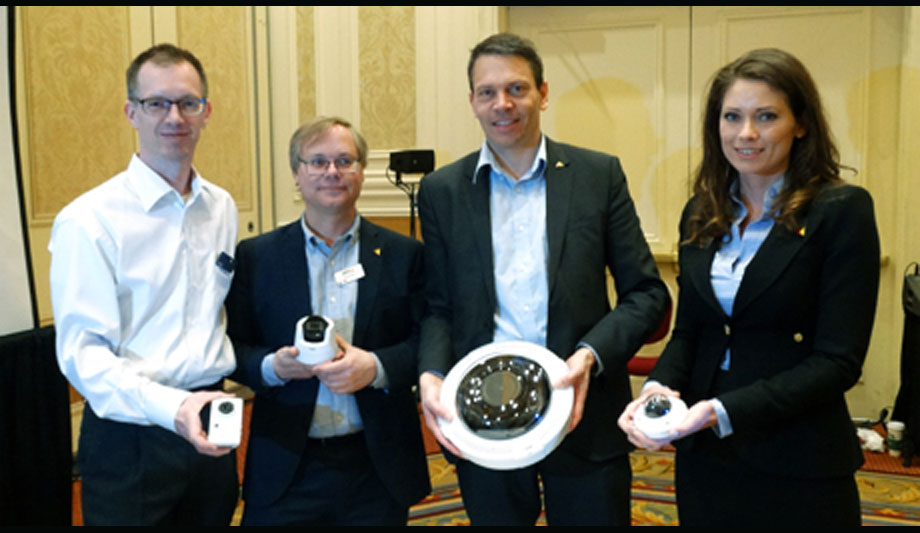ISC West was hopping on its first day, with crowded aisles, packed booths and plenty of news to share. Much of the news consists of product announcements resulting from the rapid pace of technology development in the physical security market. It was enough to cause sensory overload.
Educating integrators and end users about security technology
Technology is moving so fast that it’s understandable integrators, not to mention end users, might struggle to digest it all and apply it to their security needs. Minu Youngkin of Allegion suggests that the pace of new technology introductions, as exemplified at ISC West, is a factor compelling a shift toward a broader conversation in the industry.
“We want to be more about the message, what’s important to an integrator,” says Youngkin, who handles integrator marketing for the lock manufacturer. “We can’t just be a lock company anymore; we have to be a step above, not just talk about the product, but about the technology, and where it’s going. We align our products to software products, various credentials, and work with the right partners. We’re an important ingredient, but there are others on board, too.” The manufacturer is increasingly fulfilling a need in the market to provide education about technology. On the product side, Allegion is promoting its Engage wireless lock technology designed to be easy to install, connect, manage and use.
Axis targeting small business sector
Axis kicked off the first day of ISC West with a press conference before the show floor even opened. Axis introduced a new line of cameras targeting the small business sector, called the Companion line, promising “everything you need for small business.” Noting that smaller systems are a large part of the market (and one Axis has not historically targeted), the new camera line is aimed at serving small business needs such as limited or no knowledge of systems, only sporadic use, and cash constraints.
Axis introduced a new line of |
The new line includes some (but not all) of the features of Axis higher-end cameras, such as full HD resolution and Zipstream compression to minimise storage needs. However, the cameras are priced more competitively (translate: less expensive) to appeal to smaller users. Although the new line includes a small dome camera priced at $169, Fredrik Nilsson, Vice President, Americas, Axis Communications, says the company is not seeking to be the least expensive. “We will never compete based on price,” he says. “But we need to get close enough to [low-cost competitors] and then sell the Axis quality. We need to convince them to spend a little more for a better solution.”
Ironically, and probably not coincidentally, lower-priced camera manufacturers, notably Hikvision, are investing heavily in cracking the enterprise market at the same time Axis is looking to create more presence at the lower end.
In addition to pricing, the new Axis line includes simplified system design and implementation with components such as an 8-channel recorder for $499 and a 4-port PoE switch for $79. But Axis also introduced new cameras for its medium-sized and even enterprise customers, including a new 360-degree multi-sensor network camera. Also, the Axis Perimeter Defender is a scalable and flexible video analytics application for intrusion detection in the enterprise market. It is based on technology from Digital Barriers, a company with extensive experience in surveillance analytics.
Low bandwidth options
Zipstream is now a feature on the entire Axis camera line, helping to avoid bandwidth peaks and minimising storage needs, even for PTZ cameras. Zipstream can adjust to PTZ camera movements in real-time, offering even further storage and bandwidth savings and eliminating bitrate spikes.
Other companies are also offering lower-bandwidth options. Panasonic’s Smart Coding system, for example, promises to substantially decrease bandwidth usage and picture noise -- they claim up to 75 percent reduction. At ISC West, Panasonic is also introducing the AeroPTZ camera, a high-performance PTZ for extreme environments. The high-durability fiberglass body resists salt-air corrosion, and image stabilisation eliminates shaking from cameras mounted on tall poles.
Avigilon, another video company, is introducing the new H4 Edge Solution camera line, which includes video recorder functionality and analytics in an all-in-one edge solution. The camera records video directly to an onboard solid-state drive, thus eliminating the need for a separate network video recorder and lowering installation and systems costs.
Bosch Starlight cameras deliver high quality colour video surveillance in extremely low light conditions. They’ll take your photo inside a room at their ISC West booth, first with the lights on and then in the dark. Bosch is also now offering video analytics at the edge as a standard, rather than an optional feature.
Hot topic of cybersecurity
Cybersecurity is a big topic here. For instance, Panasonic is highlighting its use of embedded Symantec technology to protect camera streams and ensure data integrity.
Cybersecurity is not an |
Also directing a strong focus on cybersecurity at ISC West is Tyco Security Products, which is implementing some of the cybersecurity measures developed in its government business sector to apply to its broader range of products and vertical markets. In the government market, standards such as FISMA (U.S. Federal Information Security Management Act) and the NIST cybersecurity framework specify the required cybersecurity protections. Tyco is now applying the benefit of its compliance with those standards to its systems in other verticals using a six-part holistic approach. They call it the Cyber Protection Program.
“It’s all about risk management,” says William Brown, Tyco’s Senior Engineering Manager, Regulatory and Product Security. “You don’t have to install and use all the security features; you can choose your level of risk and the features that your IT department can support.” Optional features include single sign-in using an Active Directory.
Brown says physical security has been too focused on hardening each individual component while overlooking the need for a more comprehensive approach, including how to install products securely and how to respond to vulnerabilities. Tyco hopes to partner with integrators to help them understand how to meet cybersecurity needs. “Physical security is still new to cybersecurity, and it’s a constant evolution,” Brown comments. He says cybersecurity is not an “end-game,” but rather a constant process that requires vigilance.
Cyber-physical security
A new entrant focused on cybersecurity is Wurldtech, a GE division that addresses cybersecurity challenges of operational assets such as various types of computer-driven machines, focusing on vertical markets such as power, healthcare, transportation, and oil and gas. Cybersecurity of operational assets also includes ensuring cybersecurity of video and access control systems, for example, which can be an entry point for malware into an enterprise IT system (since they are often connected).
According to Wurldtech, different tools are used to protect operational technology (OT) assets as opposed to IT assets. Wurldtech’s major goal at ISC West is education. The company offers a hardware “box” to address the problems, and also has a range of services on broad issues of cybersecurity, such as assessment and evaluation of people, processes and technology. Wurldtech calls the protection of operational assets “cyber-physical security,” a term I heard today for the first time.









